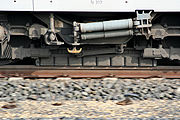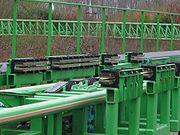
Electromagnetic brake
Encyclopedia

Friction
Friction is the force resisting the relative motion of solid surfaces, fluid layers, and/or material elements sliding against each other. There are several types of friction:...
brake
Brake
A brake is a mechanical device which inhibits motion. Its opposite component is a clutch. The rest of this article is dedicated to various types of vehicular brakes....
, is responsible for slowing an object, such as a train or a roller coaster. However, unlike electro-mechanical brakes, which apply mechanical pressure on two separate objects, eddy current brakes slow an object by creating eddy currents through electromagnetic induction
Electromagnetic induction
Electromagnetic induction is the production of an electric current across a conductor moving through a magnetic field. It underlies the operation of generators, transformers, induction motors, electric motors, synchronous motors, and solenoids....
which create resistance, and in turn either heat or electricity.
Circular eddy current brake


Rotor (electric)
The rotor is the non-stationary part of a rotary electric motor, electric generator or alternator, which rotates because the wires and magnetic field of the motor are arranged so that a torque is developed about the rotor's axis. In some designs, the rotor can act to serve as the motor's armature,...
s) are connected to a rotating coil, and a magnetic field
Magnetic field
A magnetic field is a mathematical description of the magnetic influence of electric currents and magnetic materials. The magnetic field at any given point is specified by both a direction and a magnitude ; as such it is a vector field.Technically, a magnetic field is a pseudo vector;...
between the rotor and the coil creates a resistance used to generate electricity or heat. When electromagnet
Electromagnet
An electromagnet is a type of magnet in which the magnetic field is produced by the flow of electric current. The magnetic field disappears when the current is turned off...
s are used, control of the braking action is made possible by varying the strength of the magnetic field. A braking force is possible when electric current is passed through the electromagnets. The movement of the metal through the magnetic field of the electromagnets creates eddy currents in the discs. These eddy currents generate an opposing magnetic field, which then resists the rotation of the discs, providing braking force. The net result is to convert the motion of the rotors into heat in the rotors.
Japanese Shinkansen
Shinkansen
The , also known as THE BULLET TRAIN, is a network of high-speed railway lines in Japan operated by four Japan Railways Group companies. Starting with the Tōkaidō Shinkansen in 1964, the network has expanded to currently consist of of lines with maximum speeds of , of Mini-shinkansen with a...
trains had employed circular eddy current brake system on trailer cars since 100 Series Shinkansen
100 Series Shinkansen
The is a Japanese Shinkansen high-speed train type built between 1984 and 1991 for the Tōkaidō Shinkansen and Sanyō Shinkansen high-speed lines. The earliest units have now been withdrawn from service, and the series was retired from the Tōkaidō Shinkansen line in September 2003...
. However, N700 Series Shinkansen
N700 Series Shinkansen
The is a Japanese Shinkansen high-speed train with tilting capability developed jointly by JR Central and JR West for use on the Tōkaidō and Sanyō Shinkansen lines, and also operated by JR Kyushu on the Kyushu Shinkansen line....
abandoned eddy current brakes in favour of regenerative brake
Regenerative brake
A regenerative brake is an energy recovery mechanism which slows a vehicle or object down by converting its kinetic energy into another form, which can be either used immediately or stored until needed...
s since 14 of the 16 cars in the trainset used electric motors.
Linear eddy current brake
The principle of the linear eddy current brake has been described by the French physicist FoucaultLéon Foucault
Jean Bernard Léon Foucault was a French physicist best known for the invention of the Foucault pendulum, a device demonstrating the effect of the Earth's rotation...
, hence in French the eddy current brake is called the "frein à courants de Foucault".
The linear eddy current brake consists of a magnetic yoke with electrical coils positioned along the rail, which are being magnetized alternating as south and north magnetic poles. This magnet does not touch the rail, as with the magnetic brake, but is held at a constant small distance from the rail (approximately seven millimeters).
When the magnet is moved along the rail, it generates a non-stationary magnetic field in the head of the rail, which then generates electrical tension (Faraday's induction law), and causes eddy currents. These disturb the magnetic field in such a way that the magnetic force is diverted to the opposite of the direction of the movement, thus creating a horizontal force component, which works against the movement of the magnet.
The braking energy of the vehicle is converted in eddy current losses which lead to a warming of the rail. (The regular magnetic brake, in wide use in railways, exerts its braking force by friction with the rail, which also creates heat.)
The eddy current brake does not have any mechanical contact with the rail, and thus no wear, and creates no noise or odor. The eddy current brake is unusable at low speeds, but can be used at high speeds both for emergency braking and for regular braking.
The TSI (Technical Specifications for Interoperability
Technical Specifications for Interoperability
The ERA Technical Specification for Interoperability are specifications drafted by the European Railway Agency and adopted in a Decision by the European Commission, to ensure the interoperability of the trans-European rail system...
) of the EU for trans-European high speed rail recommends that all newly built high speed lines should make the eddy current brake possible.
The first train in commercial circulation to use such a braking system has been the ICE 3
Siemens Velaro
Siemens Velaro is a family of high-speed EMU trains used in Europe and China. The Velaro is based on Deutsche Bahn's ICE 3 high-speed trains, but is a full Siemens product unlike the ICE 3 which involved other manufacturers....
.
Modern roller coaster
Roller coaster
The roller coaster is a popular amusement ride developed for amusement parks and modern theme parks. LaMarcus Adna Thompson patented the first coasters on January 20, 1885...
s also use this type of braking, but in order to avoid the risk of potential power outage
Power outage
A power outage is a short- or long-term loss of the electric power to an area.There are many causes of power failures in an electricity network...
s, they utilize permanent magnets instead of electromagnets, thus not requiring any power supply, however, without the possibility to adjust the braking strength as easily as with electromagnets.
See also
- Telma retarderTelma retarderA Telma retarder is frictionless electromagnetic braking system made by Telma, a company that is part of the Valeo group, a French automotive components manufacturer. A Telma retarder is an eddy current brake system....
– an eddy current brake system made by Telma, a company that is part of the ValeoValeoValeo is a French automotive components manufacturer.-History:The Société Anonyme Française du Ferodo was founded in 1923 in Saint-Ouen, a suburb of Paris...
group - Regenerative braking – generates electricity rather than heat and hence is usually more energy efficient
- Electromagnetic brakeElectromagnetic brakeAn eddy current brake, like a conventional friction brake, is responsible for slowing an object, such as a train or a roller coaster. However, unlike electro-mechanical brakes, which apply mechanical pressure on two separate objects, eddy current brakes slow an object by creating eddy currents...
s resp. electro-mechanical brakes – use the magnetic force to press the brake mechanically on the rail - Linear induction motorLinear induction motorA linear induction motor is an AC asynchronous linear motor that works by the same general principles as other induction motors but which has been designed to directly produce motion in a straight line....
can be used as a regenerative brake
External links
- Eddy-current braking: a long road to success. Railway Gazette InternationalRailway Gazette InternationalRailway Gazette International is a monthly business journal covering the railway, metro, light rail and tram industries worldwide. Available by annual subscription, the magazine is read in over 140 countries by transport professionals and decision makers, railway managers, engineers, consultants...
article on ICESiemens VelaroSiemens Velaro is a family of high-speed EMU trains used in Europe and China. The Velaro is based on Deutsche Bahn's ICE 3 high-speed trains, but is a full Siemens product unlike the ICE 3 which involved other manufacturers....
experience of eddy braking.

